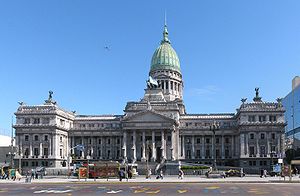- Argentine National Congress
-
Argentine National Congress
Congreso de la Nación Argentina
Type Type Bicameral Houses Senate
Chamber of DeputiesLeadership President
of the SenateJulio Cobos, UCR
since Dec 10, 2007President
of the ChamberEduardo Fellner, PJ - FPV
since Dec 10, 2007Structure Members 72 Senators (List)
257 Deputies (List)Elections Senate Last election 28 June 2009 Chamber Last election 28 June 2009 Website = The Congress of the Argentine Nation (Spanish: Congreso de la Nación Argentina) is the legislative branch of the government of Argentina. Its composition is bicameral, constituted by a 72-seat Senate and a 257-seat Chamber of Deputies.
The Congress building is located in Buenos Aires, at the western end of Avenida de Mayo (at the other end of which is located the Casa Rosada). The Kilometre Zero for all Argentine National Highways is marked on a milestone at the Congressional Plaza, next to the building.
Contents
Attributes
The Argentine National Congress is bicameral, composed of the Argentine Senate and the Argentine Chamber of Deputies. The ordinary sessions span is from March 1 to November 30; the President of Argentina is entitled to convene extraordinary sessions during the recess, if needed.[1] Senators and deputies enjoy parliamentary immunity during their mandates, which may be revoked by their peers if a senator or deputy is caught in flagrante, in the midst of committing a crime.[2]
The Congress is in charge of setting taxes and customs, which must be uniform across the country.[3] It rules the Central Bank of Argentina,[4] manages internal and external debt payment,[5] and the value of national currency[6] (currently the Argentine peso). It rules the legal codes on Civil, Commercial, Penal, Minery, Work and Social Welfare affairs, all of which cannot be in contradiction with the respective provincial codes.[7] Any changes on national or provincial limits, or the creation of new provinces, ought to be allowed by the Congress.[8]
The Congress is entitled to approve or reject every international treaty that Argentina signs with other states or international organizations. When approved, the treaties acquire priority over ordinary legislation.[9] Declarations of war and the signing of peace,[10] as well as the mobilization of the national troops, within or without of the Argentine territory[11] must be allowed by the Congress.
Building
Designed by the Italian architect Vittorio Meano and completed by Argentine architect Julio Dormal, the building was under construction between 1898 and 1906. Inaugurated that year, its aesthetic details were not completed until 1946. The quadriga atop the entrance is the work of sculptor Victor de Pol; local sculptor Lola Mora graced the interior halls and exterior alike with numerous allegorical bronzes. As time went by, the building proved too small for its purpose, and in 1974 the construction of the Annex, which now holds the Deputies' offices, was started (image, below).
Congressional Plaza was created facing the building by French Argentine urbanist Charles Thays and inaugurated in 1910. Popular among tourists, the plaza is also a preferred location for protesters and those who want to voice their opinion about Congress' activities.
The building from 1976 to 1983 housed the CAL (Legislative Advisory Commission), which was a group of officers from the three Armed Forces. Commissioned to review and discuss laws before they were issued by the Executive Branch, they served a succession of de facto military presidents during the National Reorganization Process. In practice, this became a mechanism to detect and discuss the differences between the three commanders-in-chief of the Army, Navy, and Air Force regarding a specific project. The CAL was established by the Acta del Proceso de Reorganización Nacional (National Reorganization Process Act), the guiding document for the military government established after the coup d'état of March 24, 1976.
Following a 1994 reform of the Constitution, the Senate was expanded from 48 members (two per province or district) to 72 members, whereby the party garnering second place in elections for Senator would be assured the third seat for the corresponding province.
Argentina 
This article is part of the series:
Politics and government of
Argentina- Constitution
- Government
- President (List)
- Vice President
- National Congress
- Political parties
- Elections: 2007 - 2009 - 2011
- Supreme Court
- Subdivisions
- Foreign relations
- Human rights
See also
Bibliography
- "National Constitution of Argentina" (in Spanish) Constitution of Argentina http://www.senado.gov.ar/web/interes/constitucion/cuerpo1.php
References
- ^ Argentine Constitution, art. 63
- ^ Argentine Constitution, art. 69
- ^ Argentine Constitution, art. 75, i. 1, 2 and 3
- ^ Argentine Constitution, art. 75, i.6
- ^ Argentine Constitution, art. 75, i.7
- ^ Argentine Constitution, art. 75, i.11
- ^ Argentine Constitution, art. 75, i.12
- ^ Argentine Constitution, art. 75, i.15
- ^ Argentine Constitution, art. 75, i.22
- ^ Argentine Constitution, art. 75, i.25
- ^ Argentine Constitution, art. 75, i.28
External links
Coordinates: 34°36′34.75″S 58°23′33.29″W / 34.6096528°S 58.3925806°W
Categories:- Government of Argentina
- National legislatures
- Buildings and structures in Buenos Aires
- National Historic Monuments of Argentina
- Government buildings in Argentina
- Parliaments by country
- 1906 architecture
- Bicameral legislatures
- Argentine National Congress
Wikimedia Foundation. 2010.
